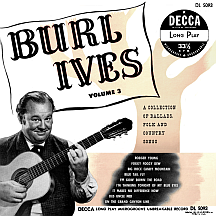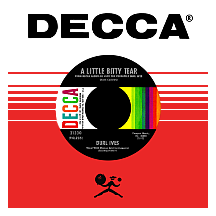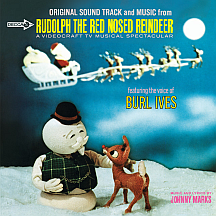BURL IVES
Seldom has an entertainer's nickname rung so true as "The Wayfaring Stranger," the phrase that identified Burl Ives when he achieved widespread popularity in the early 1940s. He'd come up with the name many years earlier after dropping out of college in 1930 at the age of 20, his interest in music and aversion to long hours of study prompting him to experience life and meet all sorts of people, wandering from place to place, hitchhiking, riding in boxcars, exploring the back roads of North America, taking temporary jobs while singing in public as often as possible, regardless of monetary gain. He spent three years going from place to place, carrying a guitar and a banjo, soaking up the atmosphere in different areas (southwestern ranches, seaboard fishing villages, campsites of all types), singing in churches, or in bars, or just out in the wide open spaces. Throughout this time, he learned hundreds of songs idigenous to various corners of the continent, practicing until each was memorized, building a mental repository of mostly-traditional American folk songs of the 19th and early 20th centuries. Could there have been a better musical training? You wouldn't have been able to convince Burl of it. Eventually the time felt right. "1933" happened to be printed on calendars in bold typeface when he headed to New York to make a go of it.
Burl Icle Ivanhoe Ives was born in Jasper County, Illinois in 1909 and raised in nearby Hunt City into a hard-working family of farmers. One of seven children (three girls, four boys), his mother, Delia White, was the first person to expose him to music in the form of Irish and Scottish folk songs representing the family's heritage. But it was his pipe-smoking, tobacco-chewing Kentucky grandmother, Kate White, who taught him most of what he knew at that age. An outgoing, approachable woman, Kate constantly delivered stories through song that left young Burl in awe: romantic, adventurous, religious, humorous and sometimes tragic tales she'd learned as a youth, enhancing them for decades afterward. By the time Burl was five, he'd been performing publicly with his siblings in nearby rural towns. People called them "Those Singing Ives."
At age seven, Burl's father bought him a banjo and before long he was playing at square dance parties and in church, a contradicting habit he took into adulthood. With his three-years-older sister Argola Ives (nickname: "Curlie"), he sang and played at a number of religious revival meetings. This continued until his teen years when he switched temporarily to sports, becoming a fullback for the Newton High School football team. Continuing with music as well, he made a few local radio appearances before enrolling at Eastern Illinois State Teacher's College in Charleston with a plan to become a football coach. At one point he was reprimanded by the president of the college for not being serious enough, so he quit to focus strictly on music. In July 1929 he traveled to Richmond, Virginia to make a "trial" recording for Gennett Records, one of the early 20th century's top labels, owned by the Starr Piano Company. The song, "Behind the Clouds," unfortunately didn't impress the Gennett people and the only copy of the recording was later destoyed. What an artifact that would be if it still existed!
Once he took to the road in the early '30s, he met all types, had skirmishes with hardened criminals and encounters with lonely women, but mostly roamed solo through the wide open spaces. Sometimes he visited larger cities in search of temporary jobs; at one point he performed on 1230AM WBOW radio in Terre Haute, Indiana. After his arrival in Manhattan in '33, he worked as a busboy, sang in churches and acted in a few summer stock productions, all the while struggling to cover the five-dollar-a-week rent for the rooming house he was staying in. He studied under Ella Toedt, an accomplished classical soprano and Juilliard voice teacher, whose opinion of his talents differed from most others: to her, his folk singing was top-notch! He began attending classes at NYU while landing some roles in amateur theater. In the fall of 1938 he made his Broadway debut with a small, non-singing part in the Richard Rodgers-Lorenz Hart musical The Boys From Syracuse, adapted by prolific N.Y. producer George Abbott from William Shakespeare's 1623 play The Comedy of Errors.
Around this time he became good friends with several-years-older actor Will Geer (latter day TV viewers will remember him in the role of Grandpa on the popular 1970s series The Waltons). Alan Lomax, a radio host and trailblazing music producer and archivist, recorded songs by both Geer and Ives, separately and together, in 1938. Not long afterwards, Burl made the acquaintance of Will's friends Woody Guthrie and Pete Seeger, already notorious as sometimes-controversial folk singers. All four found they had ideals and political leanings that were, for the most part, compatible.
Burl became a regular in New York nightclubs and was among the cast of a touring version of Rodgers and Hart's I Married an Angel. His first set of recordings took place in 1939, twelve songs that weren't released but include early versions of later Ives standards "The Foggy Foggy Dew," "Blue Tail Fly" and "Poor Wayfaring Stranger," the latter a song of German origin that was already more than 120 years old. In the spring of 1940 he began performing for the NBC Radio Network with his own series, The Wayfaring Stranger. Later in the year, he was featured on a Lomax-produced series for CBS radio, Back Where I Come From, directed by eventually-legendary film director Nicholas Ray, a national folk music program that also featured Guthrie, Seeger, Lead Belly, Josh White and other notable singers of the genre. Burl went to work for CBS and hosted two shows over the next year: The Burl Ives Coffee Club and God's Country. Lomax (who hosted Your Ballad Man on the Mutual Radio Network, in addition to the many projects that kept him busy) was a big fan of Ives, particularly impressed with his easy, natural, appealing vocal delivery, and made efforts to work with him as often as possible.
In August 1941, Burl's first commercial recordings were released on Columbia's Okeh label, eight sides that included some of the many signature tunes he would re-record over the years, like "Cowboy's Lament" and the Pete Seeger singalong "On Top of Old Smoky." In '42 he was drafted and sent to Fort Dix in New Jersey, but soon relocated to Camp Upton on Long Island, where he starred in This is the Army, an Irving Berlin musical theater presentation that caught the mood of American attitudes in the early days of the U.S. involvement in World War II and was extremely popular, with its sizeable proceeds going to the Army Emergency Relief Fund. Ives had some minor medical issues shortly afterwards and received an honorable discharge in September 1943. He resumed working for CBS Radio soon afterwards and kept busy in '44. Besides singing and acting in a number of shows and musical radio presentations, he appeared on Broadway in a folk musical, Sing Out, Sweet Land!, starring Alfred Drake and Celeste Holm, featuring Ives in the role of...what else?..."The Ballad Singer."
An album of six newly-recorded versions of earlier Ives favorites was released on the Asch label in 1944 under the title The Wayfaring Stranger and included "The Foggy Foggy Dew" and "Blue Tail Fly." Alan Lomax wrote the liner notes, singling out the title track as a "great and moving spiritual." The label also issued 78s by some of Burl's folk singer friends. A single on Stinson Records, "Solidarity Forever" (in support of trade unions), was credited to Burl Ives and the boys; Guthrie, Seeger, White and Lomax performed with him, at different times, under this name. Any or all of them could have been involved with the recording. Later in the year he signed a contract with Decca Records and in December he married Helen Peck Ehrlich, a script writer. They adopted a son, Alexander, then bought a ranch in California, splitting time between New York and their new home near the film capital of the world.
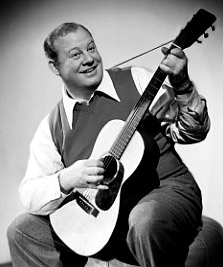
He entered the movie business in 1946 with a role in a western about a horse named Smoky; successive films, most of them westerns, included Green Grass of Wyoming and Sierra. He quit making movies for a few years after 1950, but eventually returned with a more dynamic series of popular pics.. Singles for Decca in '46 and '47 included unsurprising material like "Big Rock Candy Mountain" and "The Roving Gambler," then The Andrews Sisters joined him for an updated "Blue Tail Fly" that became his first entry on the national top 30 charts in the summer of '48. In early '49, "Lavender Blue (Dilly-Dilly)" was even bigger; Burl performed the song in the film So Dear to My Heart with novelty band Captain Stubby and the Buccaneers (the Captain's real name was Tom Fouts) and it became Burl's first single to impact both pop and C&W charts. "Riders in the Sky (A Cowboy Legend)," composed by Stan Jones, became a number one hit that spring for Vaughn Monroe and a top 30 seller for Ives.
During the period of the late '40s and early '50s when the U.S. government's House Un-American Activities Committee vigorously sought to expose citizens suspected of Communist connection or, at the very least, being Communist sympathizers, Ives' name came up on one of congress's intimidating lists. Certain comments made in his 1949 autobiography, Wayfaring Stranger, led to further scrutiny. The folk music of the era frequently contained lyrics of political protest, which resulted in the blacklisting of some singers, preventing them from appearing publicly or on television. For a time, Ives was a not-entirely-innocent target of this congress-driven movement.
In the early '50s he continued releasing records on Decca while honoring the remainder of his Columbia contract; many recordings for the latter company were yellow label children's records (Mother Goose Songs, "Two Little Owls," "The Little Engine That Could"). In 1951, as a vocalist with Percy Faith and his orchestra, Burl had his biggest hit thus far, a full chorus-backed version of "On Top of Old Smoky." Collaborations were common and a cover of Hank Thompson's major country hit "Wild Side of Life" (a song lamenting - or celebrating? - women referred to as "honky tonk angels"), with backing by Grady Martin and his Slew-Foot Five, was also a strong seller for Ives in the summer of '52. During this same time he spent several months playing the lead role in the Alan J. Lerner-Frederick Loewe musical Paint Your Wagon.
That spring, he followed Elia Kazan's lead and appeared before the House Un-American Activities Committee, defending the music he performed (despite not being requested to do so), naming four people he believed had Communist ties (who were blackballed as a result); various members of the press accused him of naming many more, perhaps even hundreds, destroying numerous people's careers only to take any heat off himself. The folk music community was noticeably displeased by his actions, which seemed to have little or no effect on the general public. He continued, unscathed, to enjoy the fruits of his career. Later, in a published review of one of Burl's albums, longtime (former?) friend Pete Seeger referred to him as a "stool pigeon" who was "gross, gargantuan, talented and clever, but not quite intelligent enough to be honorable."
As he approached the age of 50, Burl's physical size increased (at one time he weighed as much as 270 pounds), which didn't hinder his musical career, and in fact enhanced his film career, as he started getting cast in more demanding, often unsavory roles that gave him a chance to show off his acting skills. A big screen supporting role as Sam (the sheriff) in East of Eden in 1955 was immediately followed by Tennessee Williams' Pultizer Prize-winning stage play Cat on a Hot Tin Roof, a Broadway production directed by Kazan that starred Ben Gazzara, Barbara Bel Geddes and Ives in his most famous role as "Big Daddy," an arrogant plantation owner dying of cancer. His performance was a sensation with audiences and he reprised the role when the play hit the big screen in 1958 with Paul Newman and Elizabeth Taylor in the lead roles. As popular as his "Big Daddy" was, he made perhaps an even bigger impression in his next film, portraying bad guy Rufus Hannassey in The Big Country, an all-star William Wyler western with Burl's performance singled out, resulting in Oscar and Golden Globe wins for Best Supporting Actor. Some of his other notable film appearances of the late '50s were in Eugene O'Neill's Desire Under the Elms and Graham Greene's Our Man in Havana.
The peak of Ives' recording career came in 1962. Country singer-songwriter Hank Cochran supplied him with the first two of four consecutive top 40 hits, starting with "A Little Bitty Tear" ('...let me down, spoiled my act as a clown'), a whimsical weeper with emotional context embedded within Ives' usual easygoing delivery. In February 1962, it became his first song to reach the top ten (while climbing to number one on Billboard's recently-established Easy Listening chart) and received instant Grammy nominations for the 1961 calendar year in the categories Best Solo Vocal Performance, Male and Best Country and Western Recording. Then came "Funny Way of Laughin'," a variation on the same theme, a May top ten and winner the following year for Country and Western Recording, his first and only Grammy). Next came two from songwriter Harlan Howard: "Call Me Mr. In-Between," cleverly challenging listeners to buy into the 53-year-old's lyrical claim: 'Well, I'm too too old for girls and I'm too young for women...and it makes a fella mean!' The single landed in the top 20 in August. He finished out the year with another sad song of the poor boy/rich girl (/death song!) variety, "Mary Ann Regrets" ('...she's unable to see you again'), a top 40 entry in December.
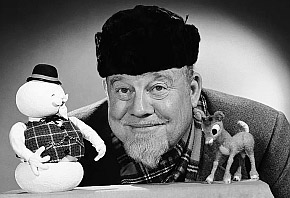
Hawaiian favorite "Pearly Shells (Popo O Ewa)" extended his chart string in the fall of 1964, just before he narrated the television special that would secure his permanent place in the music-and-video landscape of the 20th and 21st centuries. On December 6, 1964, an hourlong animated special, Rudolph the Red Nosed Reindeer, aired on NBC-TV, based on the original song written by Johnny Marks (Gene Autry's version reached number one on the charts in 1949), produced by Videocraft International, Ltd. (later Rankin/Bass). Ives narrated the special and appeared in animated form; the show introduced a slightly-over-a-minute version of Marks' "A Holly Jolly Christmas," sung by Burl (in character as Sam the Snowman) and a chorus. A slightly-over-two-minute studio version was released as a single, radio played it, and the public (not just kids) loved it, marking the beginning of a marathon of sorts.
Disney's box office blockbuster Mary Poppins, starring Julie Andrews, supplied Burl with his next notable work (though he had no involvement in the making of the film). One of the most popular Poppins songs was the lead track on Ives' album Chim Chim Cher-ee and Other Children's Choices on the Disneyland label, for which he received his fourth Grammy nomination, in the category Best Recording For Children (logically losing the award to the movie's original soundtrack). His acting resumé continued expanding with the 1965 sitcom O.K. Crackerby! (the world's richest man!?), the role of Geppetto in the 1968 animated TV movie Pinocchio and a starring role in The Bold Ones: The Lawyers from 1969 to 1972. All in all, he racked up more than 50 credits in film and television over a span of more than 40 years.
After 25 years of marriage, he and his wife divorced. The reason is unclear, but...just two months later he married interior decorator Dorothy Koster. During the '70s he made records for no less than eight labels, including his long-term label Decca in 1972, before parent company MCA retired the Decca name the following year. After spending most of the 1980s in semi-retirement, he made amends with Pete Seeger, if only for a one-night performance titled Folk Songs USA, a benefit show in New York with several other acts from his heyday. He died in 1995 in Anacortes, Washington at age 85, but in some ways it feels like he's still around; the biggest hit of his entire career, "A Holly Jolly Christmas," has increased in popularity with the passage of time, ranking among the hottest-selling, most-played songs for several weeks at the end of every year, guaranteeing Burl Ives' ongoing presence in pop culture.
NOTABLE SINGLES:
- Cowboy's Lament - 1941
- On Top of Old Smoky - 1941
- Poor Wayfaring Stranger - 1944
- The Foggy Foggy Dew - 1944
- Blue Tail Fly - 1944
- Solidarity Forever - 1946
by Burl Ives and the boys - Big Rock Candy Mountain - 1946
- The Devil's Nine Questions - 1947
- Blue Tail Fly - 1948
by the Andrews Sisters and Burl Ives - Lavender Blue (Dilly Dilly) - 1949
with Captain Stubby and the Buccaneers - Riders in the Sky (A Cowboy Legend) - 1949
- On Top of Old Smoky - 1951
by Percy Faith with Burl Ives - Wild Side of Life - 1952
by Burl Ives and Grady Martin and his Slew Foot Five - True Love Goes On and On - 1954
by Burl Ives and Gordon Jenkins - Goober Peas /
The Ballad of Davy Crockett - 1955 - Marianne - 1957
by Burl Ives with the Trinidaddies - A Little Bitty Tear - 1962
- Funny Way of Laughin' - 1962
- Call Me Mr. In-Between - 1962
- Mary Ann Regrets - 1962
- The Same Old Hurt - 1963
- Baby Come Home to Me - 1963
- I'm the Boss - 1963
- On the Front Porch - 1963
- This is All I Ask - 1963
- It Comes and it Goes - 1963
- Pearly Shells (Popo O Ewa) - 1964
- A Holly Jolly Christmas - 1964
- My Gal Sal - 1965
- Chim Chim Cheree - 1965
- Evil Off My Mind - 1966
- Lonesome 7-7203 - 1967
- I'll Be Your Baby Tonight - 1968


